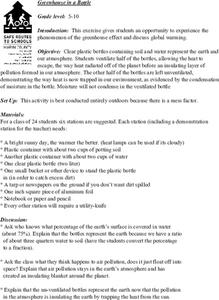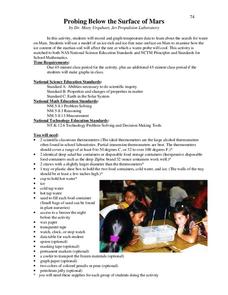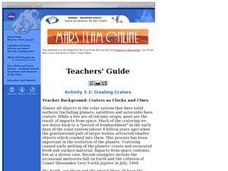Curated OER
An Overview of Solar Radiation
Students examine the Stefan-Boltzmann Law. Students compute basic radiative "constants" of the sun-Earth-atomosphere system. They examine the wavelength of maximum radiation emission.
Curated OER
Ocean Currents and Sea Surface Temperature
Students use satellite data to explore sea surface temperature. They explore the relationship between the rotation of the Earth, the path of ocean current and air pressure centers. After studying maps of sea surface temperature and ocean...
Curated OER
Weather
Young scholars gain an understanding of air pressure. In this science lesson plan, students define weather, understand pressure, specifically air pressure, demonstrate the pushing power and other properties of air, and learn how a...
Curated OER
Rocket Me into Space
Learners engage in a lesson that reinforces rockets as a vehicle that helps us explore outside the Earth's atmosphere by using the principles of Newton's third law of motion. Also, the principles that engineers deal with when building a...
Curated OER
Evaporation Introductory Lesson
Fourth graders examine the concepts of evaporation and the water cycle. They describe the relationship between heat energy, evaporation and condensation of water on Earth and identify the sun as the source of energy that evaporates...
Curated OER
Gallery Walk Questions about Energy and Material Cycles
Students state the physical, chemical or biological processes associated with these environments: Pelagic ocean zone, California coat Cave, Indiana Barrier island beach, North Carolina Sand dune, Dunes National Park, Colorado Wetland and...
Curated OER
Let's Heat Things Up!
Students build and evaluate simple models to understand the greenhouse effect. They explore the role of increased greenhouse gas concentration in global warming, and the implications of global warming theory for engineers, themselves...
Curated OER
Air and Water in the Environment
Young scholars explore the traits of water condensation and evaporation. In this water cycle lesson plan, students develop an awareness of the importance of water for sustaining life. Young scholars participate in a hands-on activity in...
Curated OER
Weather Anomalies
Ninth graders participate in a simulation of a select scientific team from the National Oceanic and Atmospheric Administration (NOAA).
Curated OER
Our Savage Planet in the News
Students research volcanoes, storms, atmospheric conditions and extreme environments. They collect information and create a simulation of a science newscast. They watch a video and write a letter as an eyewitness to an avalanche.
Curated OER
Greenhouse in a Bottle
Students create models of the greenhouse effect using recycled 2-liter bottles. They discuss how their models compares to the real greenhouse effect the earth experiences.
Curated OER
An Environmental Puzzle: The Carbon Cycle
Middle schoolers are introducced to how respiration and photosysnthesis cycle carbon through ecosystems. They read background information that describes the role of the Sun as Earth's ultimate energy source and explains how the energy...
Curated OER
How Much Oxygen Is In The Air?
In this science worksheet, young scholars take a close look at the composition of air while focusing on the content of oxygen. They use clay to model the amounts.
Curated OER
Spaced Out
Students are introduced to the space environment. This lesson covers the major differences between the environment on Earth and that of outer space and the engineering challenges that arise because of these discrepancies. In order to...
Curated OER
Exploring Explorations-Ocean Exploration
Students learn about Earth's deep ocean discoveries and their benefits. In this ocean exploration lesson, students review previous explorations of the Earth's deep oceans and learn about the discoveries of the past.
Curated OER
Probing Below the Surface of Mars
Students simulate the search for water in Mars using simple apparatus. In this space science instructional activity, students explain how soil temperature affects the cooling of probes. They graph the data collected from the simulation.
Curated OER
Solar Cycle
Students explore the solar cycle through a series of experiments. In this space science instructional activity, students construct and evaluate solar cycle graphs. They explain how this phenomenon affects the Earth.
Curated OER
Creating Craters
Students explore parts of an impact crater and compare and contrast craters found in Earth, the Moon, and Mars. Crater formation is modelled and the relationship of mass, velocity, and size of the projectile to the crater formation is...
Curated OER
'Round and 'Round it Goes!
Students discuss and interpret background knowledge on poster copy given on the water cycle. Students complete the included activity sheets using the poster as a reference in small groups. Students identify and name where water can be...
Curated OER
Global Distribution of Water
In this water activity, students are given the percent of distribution of water on earth. With the total amount of water equal to 1,000ml students determine the number of ml for each type of water on earth and color a beaker with the...
Curated OER
Follow the Sun
Learners use a simple model of the Earth and Sun as seen from space to explore the sun's apparent movement across the sky over the course of a day and year. They consider the apparent direction of movement and changes in the sun's angle.
Curated OER
Living On The Moon
Young scholars evaluate what life would be like living on the moon or another planet in our solar system. In this science lesson, students create a colony that they would use to live in on the moon using Legos.
Curated OER
The Discovery of OXygen
Learners conduct experiments to identify the different properties of oxygen. In this chemistry lesson plan, students examine its importance to life on Earth. They explore the historic dispute about oxygen's discovery.
Curated OER
Chemistry in Action
In this chemistry in action worksheet, high schoolers read about sulphuric acid, the use of metals, the production of titanium and the detection of chemical elements and compounds. Students are given 8 statements about what they...

























